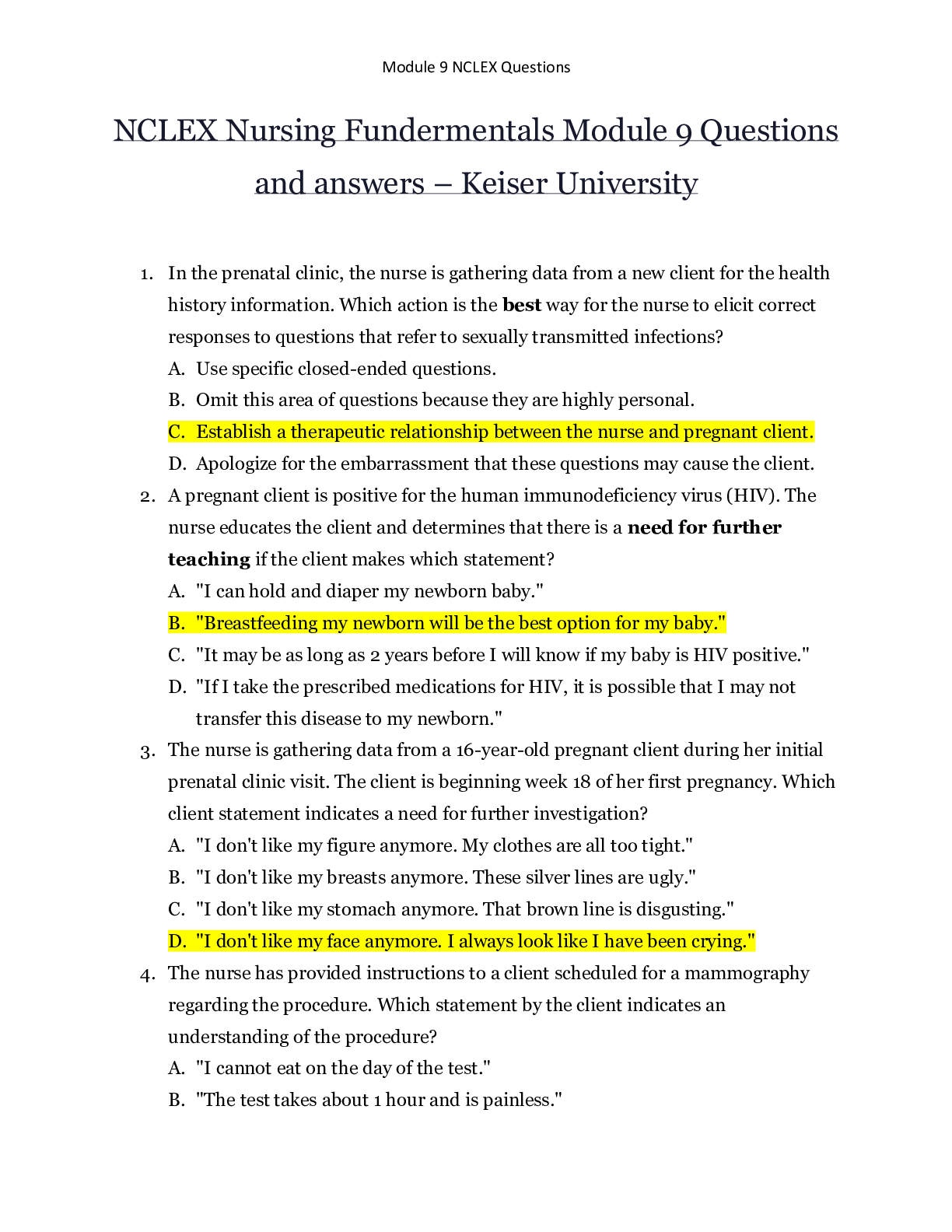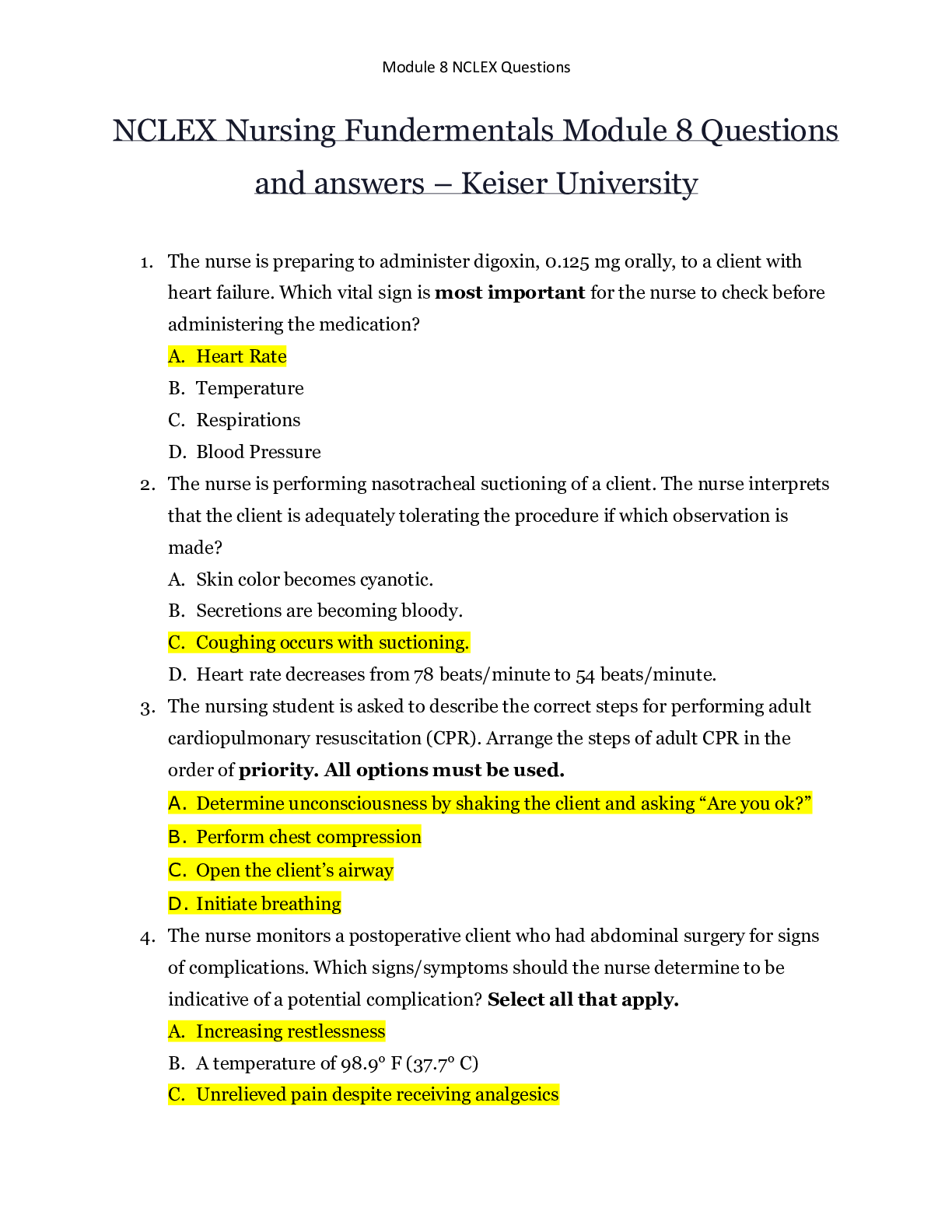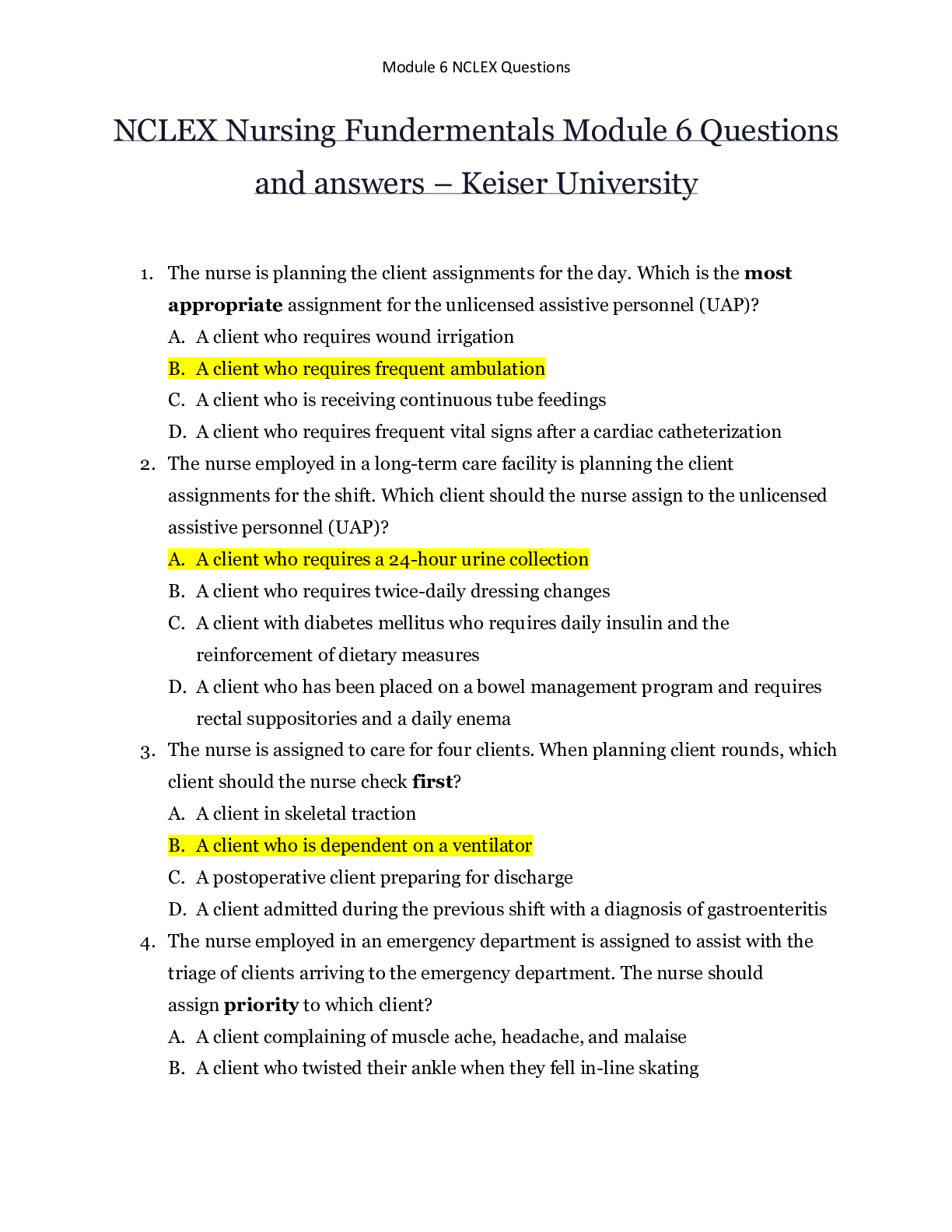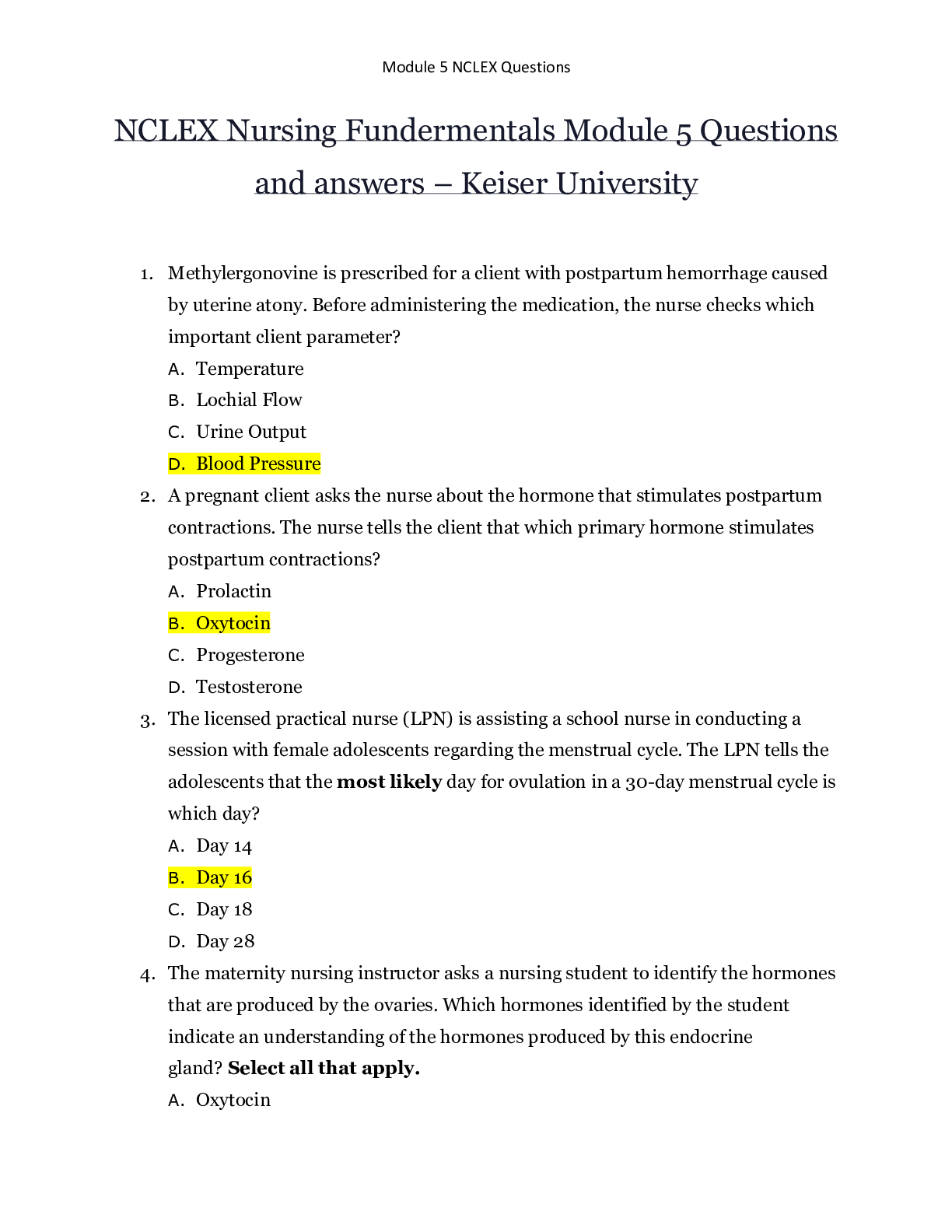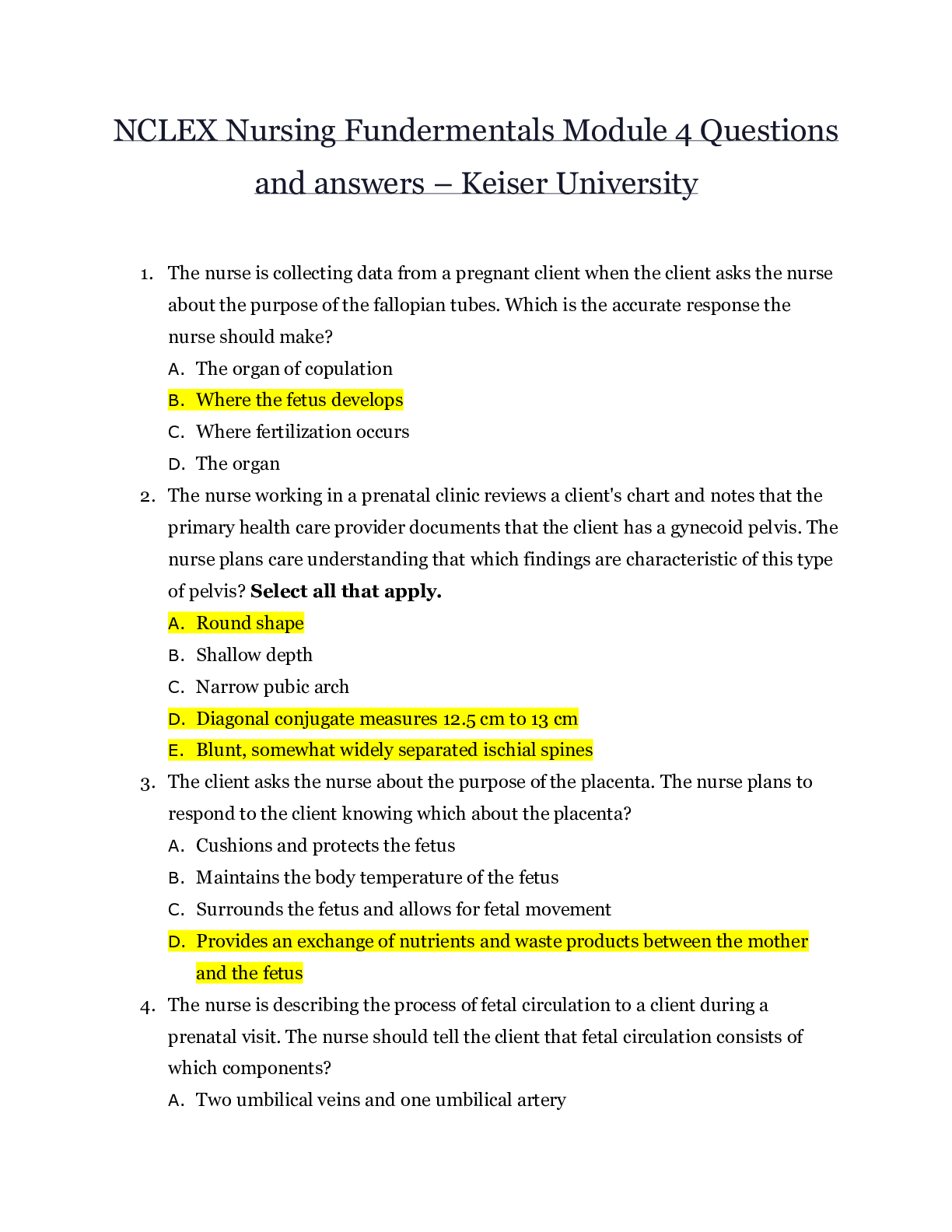Anatomy > NCLEX-RN > NUR 4940 NCLEX_Questions_OB_MATERNITY_QUESTIONS (2020) - Florida International University | NCLEX_Qu (All)
NUR 4940 NCLEX_Questions_OB_MATERNITY_QUESTIONS (2020) - Florida International University | NCLEX_Questions_OB_MATERNITY_QUESTIONS (2020)
Document Content and Description Below
NUR 4940 NCLEX_Questions_OB_MATERNITY_QUESTIONS (2020) - Florida International University NCLEX_Questions_OB_MATERNITY_QUESTIONS (2020) OB-MATERNITY ANATOMY & PHYSIOLOGY OF REPRODUCTION: 1. State t... he objective signs that signify ovulation - abundant, thin, clear cervical mucus; open cervical os; slight drop in BBT and then 0.5-1.0 F rise; ferning under the microscope 2. Ovulation occurs how many days before the next menstrual period? - 14 days. 3. State three ways to identify the chronological age of a pregnancy (gestation)? - 10 lunar months, 9 calendar months consisting of 3 trimesters of 3 months each, 40 weeks, 280 days. 4. What maternal position provides optimum fetal maternal/placental perfusion during pregnancy? - The knee-chest position, but the ideal position of COMFORT for the mother which supports fetal/maternal/placental perfusion is the side-lying position off the abdominal vessels (vena cava, aorta) 5. Name the major discomforts of the first trimester and one suggestion for amelioration of each. - Nausea and vomiting: crackers before rising. Fatigue: teach the need for rest periods/naps and 7-8 hours sleep at night. - - - - - -- - - - - - - - INTRAPARTUM: 1. List five prodromal signs of labor the nurse might teach the client. - lightening, braxton-hicks contractions increase, bloody show, loss of mucous plug, burst of energy, and nesting behaviors. 2. How is true labor discriminated from false labor? - true labor: regular, rhythmic contractions that intensify with ambulation, pain in the abdomen sweeping around from the back, and cervical changes. False labor: irregular rhythm, abdominal pain (not in back) that decreases with ambulation. 3. State 2 ways to determine if the membranes have truly ruptured (ROM).- Nitrazine testing: paper turns dark blue or black. Demonstration of fluid “ferning” under microscope. 4. Are psychoprophylactic breathing techniques prescribed for use by the stage and phase of labor? - No, clients should use these techniques according to their discomfort level and change techniques when one is no longer working for relaxation. 5. Identify two reasons to withhold anesthesia and analgesia until the mid-active phase of Stage 1 labor. - if given too early, can retard labor; if given too late, can cause fetal distress 6. Hyperventilation often occurs to the laboring client. What results from hyperventilation and what actions should the nurse take to relieve the condition? - Respiratory alkalosis occurs which is caused by blowing off CO2 and is relieved by breathing into a paper bag or cupped hands - - - - - - - - - - - - - - - 11. A woman’s white blood count returns 17,000; she is afebrile and has no symptoms of infection. What nursing action is indicated? - Continue routine assessments; normal leukocytosis occurs during postpartal period because of placental site healing. 12. What is the most common cause of uterine atony in the first 24 hours postpartum? - full bladder 13. What is the purpose of giving docusate sodium (Colace) to the postpartum client? - to soften the stool in mother’s with 3rd and 4th degree episiotomies, hemorrhoids, or Cesarean section delivery. 14. What should the fundal height be at three days postpartum for a woman who has had a vaginal delivery? - 3 fingerbreadths/cm below the umbilicus. 15. List 3 signs of positive bonding between parents and newborn? - Calling infant by name, exploration of newborn head to toe, en face position. THE NORMAL NEWBORN: 1. The newborn transitional period consists of the first ____ of life. - 6 to 8 hours of life 2. The nurse anticipates which newborn will be more at risk for problems in the transitional period. State 3 predisposing factors to respiratory depression in the newborn. - Cesarean delivery; magnesium sulfate given to mother in labor; asphyxia/fetal distress in labor. 3. What is the danger of heat loss to the newborn in the first few hours of life? - Leads to depletion of glucose (very little glycogen storage in immature liver); begins to use brown fat for energy producing ketones causing subsequent ketoacidosis and shock. 4. Normal newborn temperature is ____ = 97.7 – 99.4F Normal newborn heart rate is ____ = 110-160 bpm Normal newborn respiratory rate is ____ = 30-60 bpm Normal blood pressure is ____ = 80/50 - - - - - - - - - - - - - - - - -- 17. List symptoms of hyperbilirubinemia in the neonate. - Bilirubin levels rising 5mg/day, jaundice, dark urine, anemia, high reticulocyte (RBC) count, and dark stools. 18. Write one nursing diagnosis generated from the data pertinent to hyperbilirubinemia. - Potential for injury related to predisposition of bilirubin for fat cells in brain. 19. List 3 nursing interventions for the neonate undergoing phototherapy. - Apply opaque mask over eyes. Leave diaper loose so stools/urine can be monitored. Turn every 2 hours. Watch for dehydration. 20. List the symptoms of neonatal narcotic withdrawal. - Irritability, hyperactivity, high-pitched cry, frantic sucking, coarse flapping tremors, and poor feeding. 21. Neonates who are “sick” are prone to receive too much stimulation in the form of invasive procedures and handling too little developmentally-appropriate stimulation and affection. How might such an infant respond? - Failure to thrive, lack of crying. 22. How should the nurse determine the length of a tube needed for oral gavage feeding of a newborn? - From the bridge of the nose, to the earlobe, to a point halfway between the xiphoid and the umbilicus. 23. What are the 2 best ways to test for correct placement of the gavage tube in the infant’s stomach? - Aspiration of stomach contents with pH testing, and auscultation of air bubble injected into stomach. 24. What characteristics would the nurse expect to see in a neonate with fetal alcohol syndrome? - Microcephaly, growth retardation, short palpebral fissures, and maxillary hypophysia [Show More]
Last updated: 1 year ago
Preview 1 out of 17 pages
Instant download
 - Florida International University.png)
Buy this document to get the full access instantly
Instant Download Access after purchase
Add to cartInstant download
Reviews( 0 )
Document information
Connected school, study & course
About the document
Uploaded On
Aug 27, 2020
Number of pages
17
Written in
Additional information
This document has been written for:
Uploaded
Aug 27, 2020
Downloads
0
Views
36

 - Florida International University.png)
 - Florida International University.png)
 - Florida International University.png)


 Questions and answers – Keiser University.png)
